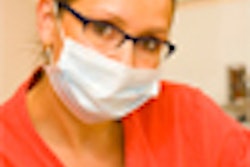
For years, I worked on the basis of an hour for each adult recall patient. But technology has allowed me to reduce my traditional recall appointment time by 10 minutes. In my office, that equates to an additional $40,000 in hygiene production over the course of a year. That's no small change, and it's all due to advances in dental materials, imaging devices, software, and hygiene equipment that have opened up an additional adult and child recall appointment for each day of hygiene.
So where did the 10 minutes come from? Let's look at the various technologies that have made my hygiene life easier.
Digital x-rays
Digital x-rays have rescued me from the depths of the darkroom. No more traveling out of the operatory and down the hallway into a broom closet, where I had to deal with cross-contamination issues while removing the films from their packaging and other patient's x-rays that were loaded prior to my patient's x-rays. I then had to travel back to my operatory, and still I was not done. An additional round-trip to the broom closet was required to sort out the films that belonged to my patient and mount those films into a holder that had a reasonable chance of falling out of the patient's chart at least 40 times over the life span of that patient.
With the digital process, films are mounted right away into the patient's file when they are exposed in the operatory, and not one film is at risk of being eaten by the processor.
Ultrasonic scalers
In the dark ages, when I was in hygiene school, the ultrasonic was in the witness protection program. I was taught that only through rigorous hand instrumentation could one achieve a glasslike root surface, which would be free of the deeply embedded endotoxins that cause periodontal disease. When I began my teaching career, I had to undergo deprogramming because research concluded that endotoxins were not imbedded deep into the cementum, but were quite superficial and could easily be removed with water and a toothbrush.
Well, guess what's been released from the witness protection program? Our handy dandy ultrasonic! I am older and wiser now. The ultrasonic cuts my scaling time in half. Even if a patient has a 1-mm bar of calculus on 23 through 26, it is worth whipping out that magnostrictive magic. I tell my patients it is faster and more efficient than me doing it by hand, and they all agree.
Sealant materials
Research has failed to find a cure for excessive saliva production during the dental visit. This made placing sealants that would actually stay on the teeth a challenge, because unless the clinician had a superdry field with no saliva contamination, the sealant would come right off. Thank goodness for the developers of the new sealant materials that can be placed outside the environmental equivalent of the Sahara desert. God bless you people. Hygienists everywhere love you. Need I say more?
Practice management software
I was born long before generation X, but I certainly enjoy the fruits of Silicon Valley. I love my dental software program. It has many bells and whistles I do not even know how to use, but it has a ton of time-saving steps and practice management functions that come to my aid every day.
I no longer have to furrow my brow trying to figure out what was completed at the last visit due to the chicken-scratch writing style used by the previous clinician. (I would be counted in that category of clinicians with chicken-scratch writing, by the way.) All pages and notes in the chart are neat and color-coordinated. At one glance, I can see incomplete treatment for each patient.
I also never have to worry about a contaminated chart that is going to make its way back up to the front desk, or work from a temporary chart because the original has grown legs and gone on a walkabout. The doctor can review the patient's x-rays and chart any concerns before ever arriving to complete the exam in my operatory. Finally, one of the biggest factors is that no one need be a slave any longer to long boxes of recall cards that have to be filled out, then resorted and double-checked prior to mailing each month. Hallelujah!
Intraoral cameras
"A picture is worth a thousand words." Someone took that saying to heart when they created intraoral cameras. Nothing says "I need attention!" like blowing up decay 500 times bigger on a color monitor. Before intraoral cameras, I know I spent four to six minutes explaining the need for any particular dental procedure. And even then, it was hard not to wonder if the patient really believed me. There is only so much the patient can see looking into a hand mirror.
But the intraoral camera has opened up a whole new world for me: class five caries on posterior teeth, stain/calculus on any lingual surface, and five-surface amalgams that appear to have lived through an earthquake. One of the things I enjoy most is the dental prophylaxis makeover "before" and "after" intraoral shots for people who tend to fall off the recall wagon. Once they can see the results of my hard work, it is easier for them to understand the additional cost.
Barriers
Last but not least, I want to mention a low-tech material that saves me time and impresses my patients: barriers. I came along before the AIDS scare in dentistry, so I remember the transition from alcohol gauze wipes to hospital-grade intermediate disinfectant sprays.
I took to barriers after learning the all-important rule that water and electricity do not mix. My thought process was, if a little disinfectant was good, a lot is better. Unfortunately, that rule does not hold true for dental chair switches. It didn't take long for my chair wiring to combust under the amount of moisture I was inflicting on it eight times a day. Most patients are already in a fight or flight state, but when the dental chair catches on fire that pretty much terminates their appointment.
For me, barriers are placed on any item that is electrical. This saves me time in operatory turnaround. My patients can visually appreciate my infection control measures, and I no longer have to worry about electrical fires.
Rhonda Jones, R.D.H., B.S., is teacher, speaker, and dental hygienist in Canton, GA.
Copyright © 2009 DrBicuspid.com



















